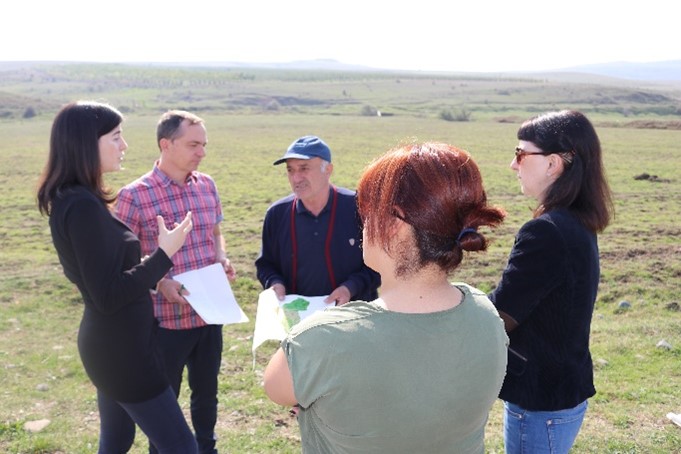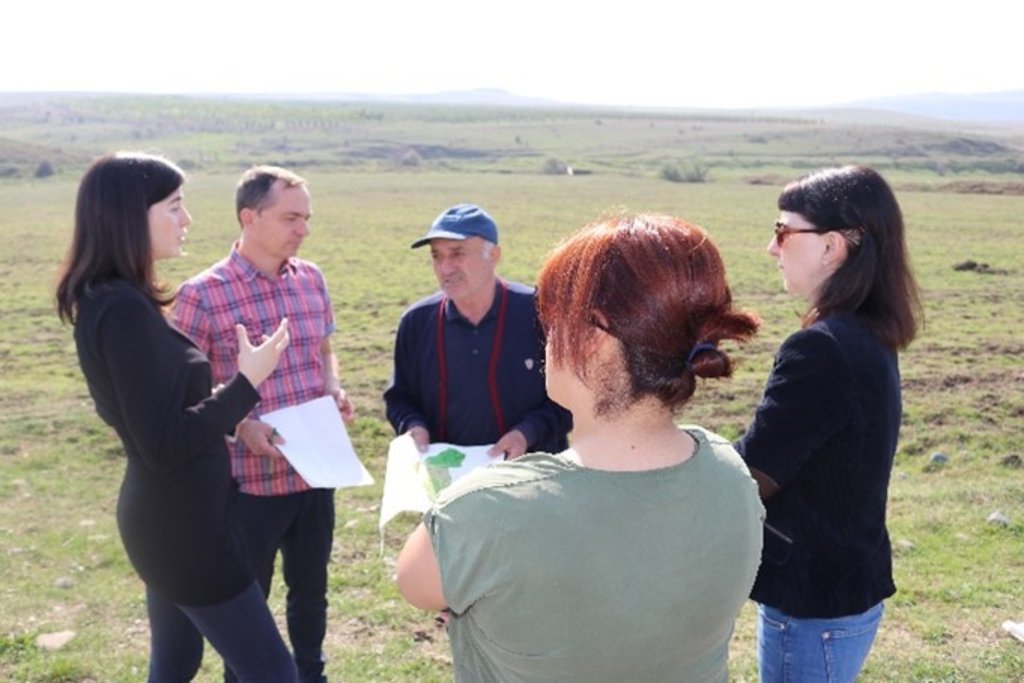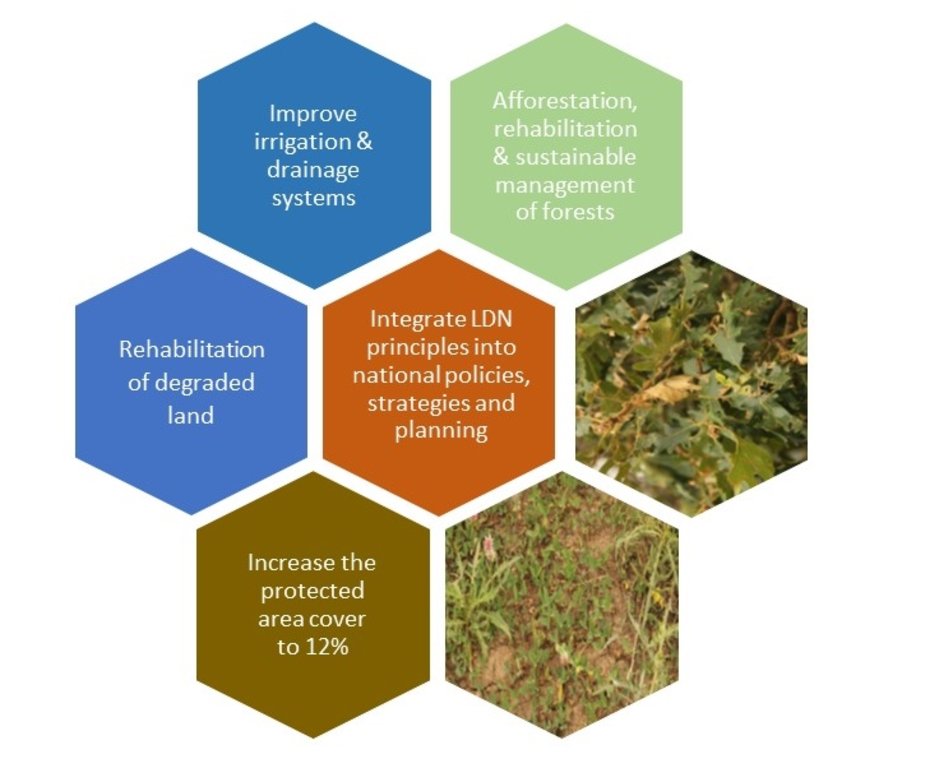Land Degradation Neutrality Transformative Projects and Programmes (LDN-TPP) for sustainable agriculture and rural development [จอร์เจีย]
- ผู้สร้างสรรค์:
- การอัพเดท:
- ผู้รวบรวม: Daniel Zollner
- ผู้เรียบเรียง: Anneliese Fuchs, Michael Huber
- ผู้ตรวจสอบ: William Critchley, Rima Mekdaschi Studer
LDN-TPP in Georgia
approaches_5902 - จอร์เจีย
ดูส่วนย่อย
ขยายทั้งหมด ย่อทั้งหมด1. ข้อมูลทั่วไป
1.2 รายละเอียดที่ติดต่อได้ของผู้รวบรวมและองค์กรที่เกี่ยวข้องในการประเมินและการจัดเตรียมทำเอกสารของแนวทาง
ผู้เชี่ยวชาญ SLM:
ผู้เชี่ยวชาญ SLM:
Zumbulidze Maia
REC Caucasus
จอร์เจีย
ชื่อของโครงการซึ่งอำนวยความสะดวกในการทำเอกสารหรือการประเมินแนวทาง (ถ้าเกี่ยวข้อง)
Generating Economic and Environmental Benefits from Sustainable Land Management for Vulnerable Rural Communities of Georgia (GREENLANDS)ชื่อของโครงการซึ่งอำนวยความสะดวกในการทำเอกสารหรือการประเมินแนวทาง (ถ้าเกี่ยวข้อง)
Global Environment Facility Georgia (GEF Georgia) - จอร์เจีย1.3 เงื่อนไขที่เกี่ยวข้องกับการใช้ข้อมูลที่ได้บันทึกไว้ผ่านทาง WOCAT
วันที่เก็บรวบรวมข้อมูล (ภาคสนาม):
04/11/2019
ผู้รวบรวมและวิทยากรหลักยอมรับเงื่อนไขเกี่ยวกับการใช้ข้อมูลที่ถูกบันทึกผ่านทาง WOCAT:
ใช่
1.4 การอ้างอิงถึงแบบสอบถามเรื่องเทคโนโลยี SLM
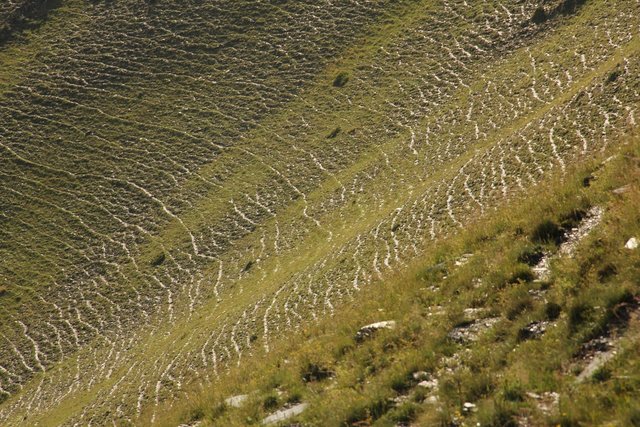
Remote Sensing as a Tool for Land Degradation … [จอร์เจีย]
Land degradation contributes to biodiversity loss and the impoverishment of rural livelihoods in Tusheti. Above all, however, land degradation are triggered by climate change as traditional land use practise might not be adapted to new climate conditions which can cause or speed up degradation processes significantly. On the other hand, …
- ผู้รวบรวม: Hanns Kirchmeir
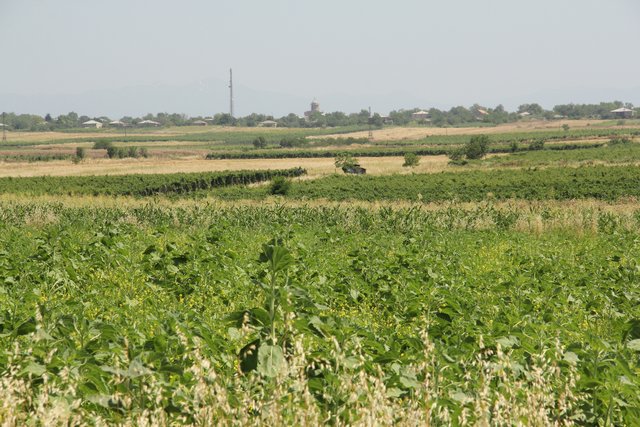
Community Land Use Planning in Arkhiloskalo [จอร์เจีย]
Unsustainable land use practices, such as deforestation, overgrazing and improper agricultural management systems are triggering the loss and degradation of valuable land resources in Georgia. Land use planning is one of the measures among others to contribute to support the integration of good Landscape and Sustainable Land Management (L-SLM) principles …
- ผู้รวบรวม: Hanns Kirchmeir
2. คำอธิบายของแนวทาง SLM
2.1 การอธิบายแบบสั้น ๆ ของแนวทาง
In the framework of the project ‘Generating Economic and Environmental Benefits from Sustainable Land Management for Vulnerable Rural Communities of Georgia’, Land Degradation Neutrality Transformative Projects and Programmes (LDN-TPP) were developed to implement the LDN targets at municipal level.
The approach defines the process to break down global and international LDN targets and to translate these into local contributions from the municipalities of Gori, Kareli, Kvareli and Sagarejo.
2.2 การอธิบายอย่างละเอียดของแนวทาง
การอธิบายอย่างละเอียดของแนวทาง:
The three-year project ‘Generating Economic and Environmental Benefits from Sustainable Land Management for Vulnerable Rural Communities of Georgia' funded by the Global Environment Facility (GEF), is implemented by the United Nations Environment Programme (UNEP) and executed by the Regional Environmental Centre for the Caucasus (RECC). The initiator and beneficiary of the project is the Ministry of Environmental Protection and Agriculture of Georgia. Within this framework, Land Degradation Neutrality Transformative Projects and Programmes (LDN-TPP) were developed to implement the LDN targets at municipal level.
The project aims to create an enabling environment at the community level to achieve the country's goal of Gender Responsive Land Degradation Neutrality (LDN). The project supports local farmers to apply sustainable land management and climate-smart agricultural practices to promote food security and resilience in order to reduce the impacts of erosion, salinisation and soil fertility reduction in Sagarejo, Kvareli, Gori and Kareli on 20,000 ha of pilot land. As a result, it is expected that there will be an improved understanding of the economics of land degradation and integrated land use planning at national and sub-national levels. In the preceding approach recorded under WOCAT, namely ‘Integrated Land Use Plans (ILUPs) for sustainable agriculture and rural development with special emphasis on SLM, CSA and LDN in four municipalities [Georgia]’, ILUPs were developed for four municipalities providing a detailed spatial basis. A separate study (Ballesteros et al. 2020) compiled baseline information about LDN indicators.
This approach complements the ILUP. It combines the spatial information elaborated for land use planning, the LDN baseline information with national LDN targets, UNCCD principles for LDN and municipal stakeholder priorities to come up with a concrete plan for the municipal contribution to (inter)national targets. Thus, this approach serves to operationalise the national LDN targets at municipal level. At the time of documentation of this apporach, planning was completed and the participatory process for validation and decision-making for concrete targets had been initiated.
Taking this into account, a targeted programme was designed, which breaks down national targets into municipal targets with related activities and spatially explicit priority areas for implementation. This approach serves to operationalise LDN-related recommendations and proposed actions as presented and defined in the Integrated Land Use Plan. It seeks to define the contribution of the municipalities Gori, Kareli, Kvareli and Sagarejo to the achievement of national and global LDN targets.
The output is intended to serve as a starting point for local discussion (especially with the LDN Working Group) to further specify and prioritise the objectives and measures proposed. It provides a solid basis for discussing (a) concrete measures and (b) the areas best suited for these measures. The approach is documented in a consolidated document on how the municipality can contribute to the national LDN goals, based on the specific situation and potentials of the municipality.
The LDN TPP focuses on specific objectives and actions in the area of the municipality and its various functional land units in a pro-active, forward-looking and visionary manner as a contribution to the nationally set LDN objectives and the overall LDN vision. It presents possible and recommended development pathways and focuses predominantly on LDN implementation options through the application and adoption of various SLM and CSA practices.
2.3 รูปภาพของแนวทาง
2.5 ประเทศ ภูมิภาค หรือสถานที่ตั้งที่ได้นำแนวทางไปใช้
ประเทศ:
จอร์เจีย
ภูมิภาค/รัฐ/จังหวัด: :
Shida Kartlii and Kakheti
ข้อมูลเฉพาะเพิ่มเติมของสถานที่ตั้ง:
Gori, Kareli, Kvareli and Sagarejo
ความคิดเห็น:
The points are located within the four municipalities of Gori, Kareli, Kvareli and Sagarejo. The land use plan was prepared for the entire territory of the four municipalities.
Map
×2.6 วันที่เริ่มต้นและสิ้นสุดของแนวทาง
ระบุปีที่เริ่ม:
2019
2.7 ประเภทของแนวทาง
- ใช้โครงงานหรือแผนงานเป็นฐาน
2.8 เป้าหมายหรือวัตถุประสงค์หลักของแนวทาง
The approach seeks to define the local contribution of the municipalities Gori, Kareli, Kvareli and Sagarejo to the achievement of national and global LDN targets whilst meeting local needs and priorities
2.9 เงื่อนไขที่เอื้ออำนวยหรือเป็นอุปสรรคต่อการนำเทคโนโลยีภายใต้แนวทางนี้ไปปฏิบัติใช้
บรรทัดฐานและค่านิยมทางสังคม วัฒนธรรม ศาสนา
- เอื้ออำนวย
There is a recognised need to improve land use planning and to counter land degradation as agricultural production is declining
การมีไว้ให้หรือการเข้าถึงแหล่งการเงินและบริการ
- เป็นอุปสรรค
Even though funding is provided through the project, the resources available at the municipality are very limited.
การจัดตั้งระดับองค์กร
- เอื้ออำนวย
The establishment of Municipal LDN Working groups allows for a concrete discussion of LDN with adequate municipal participation. It also allows for including local knowledge in the planning process
- เป็นอุปสรรค
Currently, municipalities have very limited capacities for land use planning.
การร่วมมือหรือการทำงานประสานกันของผู้ลงมือปฏิบัติ
- เอื้ออำนวย
REC has a very strong presence and links to the municipalities through previous and ongoing projects.
- เป็นอุปสรรค
This was very challenging due to COVID-19 restrictions. Fewer meetings were held than foreseen delaying the process of discussion of municipal targets and activities.
กรอบแนวทางในการดำเนินการด้านกฎหมาย (การถือครองที่ดิน สิทธิในการใช้ที่ดินและน้ำ)
- เป็นอุปสรรค
For the strategic planning, land tenure was only a minor topic. However, in general, when it comes to the specific location of measures, land tenure will be amongst the key issues.
นโยบาย
- เอื้ออำนวย
Well-supported through municipal involvement.
การกำกับดูแลที่ดิน (การตัดสินใจ การนำเอาไปปฏิบัติใช้ และการบังคับใช้)
- เอื้ออำนวย
Municipal LDN group as municipal sounding board was a big plus.
ความรู้เกี่ยวกับ SLM การเข้าถึงการสนับสนุนด้านเทคนิค
- เอื้ออำนวย
There are several successful previous projects already providing a good set of measures and creating awareness amongst land users for SLM
3. การมีส่วนร่วมและบทบาทของผู้มีส่วนได้ส่วนเสียที่เกี่ยวข้อง
3.1 ผู้มีส่วนได้ส่วนเสียที่เกี่ยวข้องในแนวทางนี้และบทบาท
- ผู้ใช้ที่ดินระดับท้องถิ่นหรือชุมชนระดับท้องถิ่น
Various farmers
Visits to the fields with the local farmers, discussions about the type of cultivation
- นักวิจัย
Tbilisi State University
Contribution of expert knowledge during meetings to interpret findings in a municipal context; provision of relevant scientific data;
- องค์กรพัฒนาเอกชน
REC Caucasus
Supervisors, consultants, GIS analyses, participation in the LDN Working Group Meeting
- รัฐบาลระดับท้องถิ่น
Executive Office of the Gori Municipal Council
I Mayor’s City Hall (formerly Municipal Administration“Gamgeoba”), Municipality of Gori
I Mayor’s City Hall (formerly Municipal Administration“Gamgeoba”), Municipality of Kareli
I Mayor’s City Hall (formerly Municipal Administration“Gamgeoba”), Municipality of Kvareli
I Mayor’s City Hall (formerly Municipal Administration“Gamgeoba”), Municipality of Sagarejo
Participation in the LDN Working Group Meeting
- รัฐบาลแห่งชาติ (ผู้วางแผน ผู้ทำการตัดสินใจ)
Agricultural and Rural Development Agency (ARDA)
Ministry of Environmental Protection and Agriculture of Georgia (MEPA)
Participation in the LDN Working Group Meeting
3.2 การเกี่ยวข้องของผู้ใช้ที่ดินระดับท้องถิ่นหรือชุมชนระดับท้องถิ่นในช่วงต่างๆของแนวทาง
| ความเกี่ยวข้องของผู้ใช้ที่ดินระดับท้องถิ่นหรือชุมชนระดับท้องถิ่น | ระบุผู้ที่มีส่วนเกี่ยวข้องและอธิบายกิจกรรม | |
|---|---|---|
| การริเริ่มหรือการจูงใจ | ไม่มี | |
| การวางแผน | ไม่ลงมือ | Local land users were consulted to gain experience and insight into the situation of agriculture in the different areas. The interviews were then incorporated in the preparation of the maps and land use plans. Stakeholder priorities formulated during the meetings were the basis for the setting of the municipal targets. Due to COVID 19 the related participatory process to validate the proposed targets, activities and locations has only started recently. Thus, finally the classification would rather refer to "interactive planning". |
| การดำเนินการ | ไม่มี | |
| การติดตามตรวจสอบหรือการประเมินผล | ไม่มี | M&E will be provided in a later stage once the decisions are made regarding the final activities and priorities |
3.4 การตัดสินใจเลือกใช้เทคโนโลยี SLM
ระบุผู้ที่ทำการตัดสินใจเลือกเทคโนโลยีมากกว่าหนึ่งวิธีไปปฏิบัติใช้:
- ผู้เชี่ยวชาญ SLM เป็นผู้ตัดสินใจหลัก ที่ติดตามให้คำปรึกษากับผู้ใช้ที่ดิน
การอธิบาย:
After initial consultations, the plan was prepared based on scientific and GIS-based information translating it into a muncipal programme. The process will be concluded once the programme is validated and discussed with land users and municipal administration (ongoing process).
ระบุว่าการตัดสินใจตั้งอยู่บนพื้นฐานของ:
- การประเมินความรู้ SLM ที่ได้ทำการบันทึกไว้เป็นอย่างดี (การใช้ข้อมูลในการตัดสินใจ)
- สิ่งที่ค้นพบจากงานวิจัย
- ประสบการณ์และความคิดเห็นส่วนตัว (ไม่ได้ลงบันทึกไว้)
4. การสนับสนุนด้านเทคนิค การสร้างขีดความสามารถ และการจัดการด้านความรู้
4.1 การสร้างขีดความสามารถ / การอบรม
ได้มีการจัดอบรมให้แก่ผู้ใช้ที่ดินหรือผู้มีส่วนได้ส่วนเสียคนอื่น ๆ หรือไม่:
ไม่ใช่
4.2 การบริการให้คำแนะนำ
ผู้ใช้ที่ดินมีการเข้าถึงการรับบริการให้คำปรึกษาหรือไม่:
ไม่ใช่
4.3 การเสริมความแข็งแกร่งให้กับสถาบัน (การพัฒนาองค์กร)
สถาบันได้รับการจัดตั้งขึ้นมาหรือเสริมความแข็งแกร่งโดยแนวทางนี้หรือไม่:
- ใช่ เล็กน้อย
ระบุระดับของสถาบันที่ได้รับการเสริมความแข็งแกร่งหรือจัดตั้งขึ้นมา:
- ท้องถิ่น
อธิบายถึงสถาบัน บทบาทและความรับผิดชอบ สมาชิก เป็นต้น:
Within the framework of the project, municipal Land Degradation Neutrality Groups were established comprising municipal stakeholders and land users. This board serves to discuss LDN issues, define priorities and provide knowledge about local phenomena of land degradation (e.g. participatory mapping of degradation)
ระบุประเภทของการให้ความช่วยเหลือสนับสนุน:
- การสร้างขีดความสามารถ / การอบรม
ให้รายละเอียดเพิ่มเติม :
Basically, these groups were consulted for the identification of priorities and land-degradation mapping in the municipality. In a follow-up step, these groups will play a crucial role in decision-making and implementation of the programme.
4.4 การติดตามตรวจสอบและประเมินผล
การติดตามตรวจสอบและประเมินผลเป็นส่วนหนึ่งของแนวทางหรือไม่:
ไม่ใช่
ความคิดเห็น:
The current approach designed a LDN-TPP at municipal level. Once the municipality decides about the final priorities and measures to be taken, a monitoring plan will be included.
4.5 การวิจัย
การวิจัยเป็นส่วนหนึ่งของแนวทางหรือไม่:
ใช่
ระบุหัวข้อเรื่อง:
- สังคมวิทยา
- นิเวศวิทยา
- เทคโนโลยี
ให้ข้อมูลเพิ่มเติมและให้ระบุผู้ทำการวิจัย:
The designed programme builds on 3 main elements: (1) local knowledge through project-based experiences and implicit knowledge of land users and the LDN group, (2) a spatial analysis of land use within the frame of the land-use planning process (see Zollner, 2021, separate approach recorded under Wocat) and (3) a LDN baseline study about the three global LDN indicators (land cover, net primary production and soil organic carbon) (Ballesteros et al. 2020).
5. การสนับสนุนด้านการเงินและวัสดุอุปกรณ์
5.1 ระบุงบประมาณประจำปีสำหรับแนวทาง SLM นี้
ถ้าหากว่างบประมาณประจำปีไม่เป็นที่ทราบแน่นอน ให้ระบุช่วงลงไป:
- 10,000-100,000
แสดงความคิดเห็น (แหล่งของการระดมทุน ผู้บริจาคคนสำคัญ):
This amount covers the elaboration of four programmes for four municipalities excluding the final implementation. Depending on the funding source and the final political decisions, the implementation of the programmes ranges from 500,000 - 4,000,000 USD. The costs for this process were funded by GEF via UNDP.
5.2 การสนับสนุนด้านการเงิน / วัสดุอุปกรณ์ให้แก่ผู้ใช้ที่ดิน
ผู้ใช้ที่ดินได้รับการสนับสนุนด้านการเงิน / วัสดุอุปกรณ์ไปปฏิบัติใช้เทคโนโลยีหรือไม่:
ไม่ใช่
5.3 เงินสนับสนุนสำหรับปัจจัยนำเข้า (รวมถึงแรงงาน)
- ไม่มี
5.4 เครดิต
มีการจัดหาเครดิตมาให้ภายใต้แนวทาง SLM หรือไม่:
ไม่ใช่
5.5 แรงจูงใจหรือเครื่องมืออื่น ๆ
แรงจูงใจหรือเครื่องมืออื่น ๆ ได้ถูกนำไปใช้ส่งเสริมการใช้เทคโนโลยี SLM หรือไม่:
ไม่ใช่
6. การวิเคราะห์ผลกระทบและการสรุป
6.1 ผลกระทบของแนวทาง
ช่วยในการตัดสินใจโดยดูจากหลักฐาน ได้หรือไม่:
- ไม่ใช่
- ใช่ เล็กน้อย
- ใช่ ปานกลาง
- ใช่ อย่างมาก
It provides hard facts and spatial information about degradation, priority areas and potential measures for decision-makers
ช่วยให้ผู้ใช้ที่ดินนำเอาเทคโนโลยี SLMไปใช้และบำรุงรักษาสภาพไว้ได้หรือไม่:
- ไม่ใช่
- ใช่ เล็กน้อย
- ใช่ ปานกลาง
- ใช่ อย่างมาก
Not yet. As it is a plan.
ปรับปรุงความร่วมมือกันและการดำเนิน งานของ SLM ได้อย่างมีประสิทธิผลหรือไม่:
- ไม่ใช่
- ใช่ เล็กน้อย
- ใช่ ปานกลาง
- ใช่ อย่างมาก
It links the land-use planning process (and its results) with scientific information and translates it into actions - it builds on existing knowledge.
ระดมกำลังหรือปรับปรุงการเข้าถึงแหล่ง เงินทุนสำหรับการดำเนินการ SLM หรือไม่:
- ไม่ใช่
- ใช่ เล็กน้อย
- ใช่ ปานกลาง
- ใช่ อย่างมาก
By linking local priorities with (inter)national obligations, it is expected that it will help to mobilise additional resources.
ปรับปรุงความรู้และความสามารถของผู้ใช้ที่ดินในการดำเนินการ SLM หรือไม่:
- ไม่ใช่
- ใช่ เล็กน้อย
- ใช่ ปานกลาง
- ใช่ อย่างมาก
It provides solid condensed and local information to the Municipal LDN group
ปรับปรุงความรู้และความสามารถของผู้มีส่วนได้ส่วนเสียคนอื่น ๆ ให้ดีขึ้นหรือไม่:
- ไม่ใช่
- ใช่ เล็กน้อย
- ใช่ ปานกลาง
- ใช่ อย่างมาก
Close cooperation with international experts and local consultants increased the GIS-mapping capabilities of the national expert.
ทำให้ผู้ใช้ที่ดินระดับท้องถิ่นมีอำนาจขึ้น ปรับปรุงการเข้าร่วมของผู้มีส่วนได้ส่วนเสียให้ดีขึ้นหรือไม่:
- ไม่ใช่
- ใช่ เล็กน้อย
- ใช่ ปานกลาง
- ใช่ อย่างมาก
The municipal LDN group is a cross-institutional group of municipal stakeholders dealing with land degradation at municipal level.
ช่วยบรรเทาความขัดแย้งหรือไม่:
- ไม่ใช่
- ใช่ เล็กน้อย
- ใช่ ปานกลาง
- ใช่ อย่างมาก
This is expected to happen as together with land use planning it identifies priorities, challenges and needs.
ทำให้กลุ่มด้อยโอกาสมีอำนาจทางสังคมและเศรษฐกิจหรือไม่:
- ไม่ใช่
- ใช่ เล็กน้อย
- ใช่ ปานกลาง
- ใช่ อย่างมาก
Not yet, as these groups have not yet been involved - but will be involved (particularly land-users) who are the final beneficiaries of the measures.
ปรับปรุงความทัดเทียมกันด้านเพศและให้อำนาจแก่ผู้หญิงและเด็กผู้หญิงหรือไม่:
- ไม่ใช่
- ใช่ เล็กน้อย
- ใช่ ปานกลาง
- ใช่ อย่างมาก
It was not a major consideration. Work was only with the Municipal LDN group (which included women).
ส่งเสริมให้เยาวชนหรือบุตรหลานของผู้ใช้ที่ดินให้เข้าร่วมใน SLM:
- ไม่ใช่
- ใช่ เล็กน้อย
- ใช่ ปานกลาง
- ใช่ อย่างมาก
It was not a major consideration. Work was only with the Municipal LDN group
ปรับปรุงประเด็นของการถือครองที่ดินหรือสิทธิในการใช้ ซึ่งขัดขวางการนำเทคโนโลยีไปใช้ให้ดีขึ้น:
- ไม่ใช่
- ใช่ เล็กน้อย
- ใช่ ปานกลาง
- ใช่ อย่างมาก
It addresses and highlights some of the pressing issues.
นำไปสู่ความมั่นคงด้านอาหารหรือปรับปรุงโภชนาการให้ดีขึ้น:
- ไม่ใช่
- ใช่ เล็กน้อย
- ใช่ ปานกลาง
- ใช่ อย่างมาก
Not yet, but if implemented, it will make a major contribution.
ปรับปรุงการเข้าถึงตลาดหรือไม่:
- ไม่ใช่
- ใช่ เล็กน้อย
- ใช่ ปานกลาง
- ใช่ อย่างมาก
Not yet, but if implemented, it will make a major contribution.
นำไปสู่การเข้าถึงเรื่องน้ำและสุขาภิบาลได้ดีขึ้นหรือไม่:
- ไม่ใช่
- ใช่ เล็กน้อย
- ใช่ ปานกลาง
- ใช่ อย่างมาก
Not yet, but if implemented, it will make a significant contribution as water security , sustainable irrigation, and protection of water resources are key topics.
นำไปสู่การใช้ที่ดินอย่างยั่งยืนหรือแหล่งพลังงานหรือไม่:
- ไม่ใช่
- ใช่ เล็กน้อย
- ใช่ ปานกลาง
- ใช่ อย่างมาก
Not a priority.
ปรับปรุงความสามารถของผู้ใช้ที่ดินในการปรับตัวให้เข้ากับการเปลี่ยนแปลงของสภาพภูมิอากาศหรือสภาพที่รุนแรงและภัยพิบัติหรือไม่:
- ไม่ใช่
- ใช่ เล็กน้อย
- ใช่ ปานกลาง
- ใช่ อย่างมาก
Not yet, but if implemented, this is supposed to be one of the major contributions of the programme.
นำไปสู่โอกาสในการจ้างงาน รายได้หรือไม่:
- ไม่ใช่
- ใช่ เล็กน้อย
- ใช่ ปานกลาง
- ใช่ อย่างมาก
Not yet, but it seeks to enhance and secure incomes of farmers in the muncipality and outlines alternative income opportunities
6.2 แรงจูงใจหลักของผู้ใช้ที่ดินเพื่อที่จะนำ SLM ไปปฏิบัติใช้
- การผลิตที่เพิ่มขึ้น
- กำไร (ความสามารถ) อัตราส่วนค่าใช้จ่ายต่อผลประโยชน์ที่เพิ่มขึ้น
- การเสื่อมของที่ดินลดลง
- ความเสี่ยงของภัยพิบัติลดลง
- การเข้าร่วมสมทบในขบวนการ โครงการ กลุ่ม เครือข่าย
6.3 ความยั่งยืนของกิจกรรมของแนวทาง
ผู้ใช้ที่ดินสามารถทำให้สิ่งต่างๆ ที่ได้ปฏิบัติใช้โดยแนวทางนี้ยั่งยืนได้หรือไม่ (โดยไม่มีการสนับสนุนจากภายนอก):
- ใช่
ถ้าตอบว่าใช่ ให้อธิบายว่าอย่างไร :
The programme seeks agricultural transformation and a change in agricultural practice both reducing land degradation and increasing land productivity
6.4 จุดแข็งและข้อได้เปรียบของแนวทาง
| จุดแข็ง / ข้อได้เปรียบของแนวทางในทัศนคติของผู้ใช้ที่ดิน |
|---|
| Allows for a discussion based on maps displaying degradation challenges. This makes it easier to concretly agree on measures and priorities |
| จุดแข็ง / ข้อได้เปรียบของแนวทางในทัศนคติของผู้รวบรวมหรือวิทยากรหลัก |
|---|
| Combination of stakeholder priorities, local conditions, scientific baseline information and spatially very clear maps |
| Linking different plans and strategies with (inter)national obligations and targets at local level. This is a good basis for attracting funding and targeted interventions |
| Comprehensive, intersectoral and local approach connecting climate change, agricultural development, ecological and social aspects |
6.5 จุดอ่อน / ข้อเสียเปรียบของแนวทางและวิธีในการแก้ไข
| จุดอ่อน / ข้อเสียเปรียบในทัศนคติของผู้ใช้ที่ดิน | สามารถแก้ไขปัญหาได้อย่างไร |
|---|---|
| Local capacities are rather low and require external funding | Increased capacity building of the Muncipal LDN Group as key resource |
| จุดอ่อน / ข้อเสียเปรียบในทัศนคติของผู้รวบรวมหรือวิทยากรหลัก | สามารถแก้ไขปัญหาได้อย่างไร |
|---|---|
| Due to COVID 19 a more participatory discussion of targets and exact location and scope of measures is still required (but planned) | The planning process can be extended to enable the participatory process |
| Without a capable local lead, it will be challenging | With REC which has been involved for a long time in the region, capable support and exact knowledge of local capacities is available. |
7. การอ้างอิงและการเชื่อมต่อ
7.1 วิธีการหรือแหล่งข้อมูล
- ไปเยี่ยมชมภาคสนาม การสำรวจพื้นที่ภาคสนาม
One field visit of the international consultant (Meeting with LDN Municipal Group, participatory mapping, onsite visit, consultations with stakeholders) and several visits of the RECC.
- การสัมภาษณ์กับผู้ใช้ที่ดิน
During the field visit
- การเก็บรวบรวมมาจากรายงานและเอกสารที่มีอยู่
7.2 การอ้างอิงถึงสิ่งตีพิมพ์
ชื่อเรื่อง ผู้เขียน ปี ISBN:
Ballesteros Canovas, J.A., Da Silva Correia, G., Schlechten, J., Zumbulidze, M. & Stoffel, M. 2020: Report. Generating Economic and Environmental Benefits from Sustainable Land Management for Vulnerable Rural Communities of Georgia. University of Geneva
ช่องทางในการสืบค้น และราคา:
REC Caucasus
ชื่อเรื่อง ผู้เขียน ปี ISBN:
Huber, M., Zollner, D., Zumbulidze, M., 2021: Sagarejo Land Degradation Neutrality Transformative Programme (LDN-TPP Sagarejo) for sustainable agriculture and rural development with special emphasis on SLM, CSA and LDN (Part B – LDN TPP Sagarejo). Version 2.0. Klagenfurt, Tbilisi, Sagarejo. 56 p.
ช่องทางในการสืบค้น และราคา:
REC Caucasus
ชื่อเรื่อง ผู้เขียน ปี ISBN:
Huber, M., Zollner, D., Zumbulidze, M., 2021: Kareli Land Degradation Neutrality Transformative Programme (LDN-TPP Kareli) for sustainable agriculture and rural development with special emphasis on SLM, CSA and LDN (Part B – LDN-TPP Kareli). Version 2.0. Klagenfurt, Tbilisi, Kareli. 61 p.
ช่องทางในการสืบค้น และราคา:
REC Caucasus
ชื่อเรื่อง ผู้เขียน ปี ISBN:
Huber, M., Zollner, D., Zumbulidze, M., 2021: Gori Land Degradation Neutrality Transformative Programme (LDN-TPP Gori) for sustainable agriculture and rural development with special emphasis on SLM,CSA and LDN (Part B – LDN-TPP Gori). Version 2.0. Klagenfurt, Tbilisi, Gori. 55 p.
ช่องทางในการสืบค้น และราคา:
REC Caucasus
ชื่อเรื่อง ผู้เขียน ปี ISBN:
Huber, M., Zollner, D., Zumbulidze, M., 2021: Kvareli Land Degradation Neutrality Transformative Programme (LDN-TPP Kvareli) for sustainable agriculture and rural development with special emphasis on SLM, CSA and LDN (Part B – ILUP Kvareli). Version 2.0. Klagenfurt, Tbilisi, Kvareli. 54 p.
ช่องทางในการสืบค้น และราคา:
REC Caucasus
ชื่อเรื่อง ผู้เขียน ปี ISBN:
Zollner, D., Zumbulidze, M., Kirchmeir, H., Fuchs, A. und Huber, M. 2021: Gori Integrated Land Use Plan (ILUP Gori) for sustainable agriculture and rural development with special emphasis on SLM, CSA and LDN. Part A – ILUP Gori. Version 2.0. Klagenfurt, Tbilisi, Gori. 80 p. + documentation volume/ annex.: REC Caucasus, E.C.O- Institute of Ecology
ช่องทางในการสืบค้น และราคา:
REC Caucasus
ชื่อเรื่อง ผู้เขียน ปี ISBN:
Zollner, D., Zumbulidze, M., Kirchmeir, H., Fuchs, A. und Huber, M. 2021: Kareli Integrated Land Use Plan (ILUP Gori) for sustainable agriculture and rural development with special emphasis on SLM, CSA and LDN. Part A – ILUP Gori. Version 2.0. Klagenfurt, Tbilisi, Gori. 80 p. + documentation volume/ annex.: REC Caucasus, E.C.O- Institute of Ecology
ช่องทางในการสืบค้น และราคา:
REC Caucasus
ชื่อเรื่อง ผู้เขียน ปี ISBN:
Zollner, D., Zumbulidze, M., Kirchmeir, H., Fuchs, A. und Huber, M. 2021: Kvareli Integrated Land Use Plan (ILUP Gori) for sustainable agriculture and rural development with special emphasis on SLM, CSA and LDN. Part A – ILUP Gori. Version 2.0. Klagenfurt, Tbilisi, Gori. 80 p. + documentation volume/ annex.:REC Caucasus, E.C.O- Institute of Ecology
ช่องทางในการสืบค้น และราคา:
REC Caucasus
ชื่อเรื่อง ผู้เขียน ปี ISBN:
Zollner, D., Zumbulidze, M., Kirchmeir, H., Fuchs, A. und Huber, M. 2021: Sagarejo Integrated Land Use Plan (ILUP Gori) for sustainable agriculture and rural development with special emphasis on SLM, CSA and LDN. Part A – ILUP Gori. Version 2.0. Klagenfurt, Tbilisi, Gori. 80 p. + documentation volume/ annex.: REC Caucasus, E.C.O- Institute of Ecology
ช่องทางในการสืบค้น และราคา:
REC Caucasus
7.3 เชื่อมโยงกับข้อมูลที่มีอยู่บนออนไลน์
ชื่อเรื่องหรือคำอธิบาย:
UNCCD Checklist for Land Degradation Neutrality Transformative Projects and Programmes (LDN TPP)
URL:
https://knowledge.unccd.int/sites/default/files/2018-09/LDN%20TPP%20checklist%20final%20draft%20040918.pdf
ชื่อเรื่องหรือคำอธิบาย:
UNCCD Land Degradation Neutrality Transformative Projects and Programmes: Operational Guidance for Country Support
URL:
https://www.unccd.int/publications/land-degradation-neutrality-transformative-projects-and-programmes-operational
ลิงก์และโมดูล
ขยายทั้งหมด ย่อทั้งหมดลิงก์

Remote Sensing as a Tool for Land Degradation … [จอร์เจีย]
Land degradation contributes to biodiversity loss and the impoverishment of rural livelihoods in Tusheti. Above all, however, land degradation are triggered by climate change as traditional land use practise might not be adapted to new climate conditions which can cause or speed up degradation processes significantly. On the other hand, …
- ผู้รวบรวม: Hanns Kirchmeir

Community Land Use Planning in Arkhiloskalo [จอร์เจีย]
Unsustainable land use practices, such as deforestation, overgrazing and improper agricultural management systems are triggering the loss and degradation of valuable land resources in Georgia. Land use planning is one of the measures among others to contribute to support the integration of good Landscape and Sustainable Land Management (L-SLM) principles …
- ผู้รวบรวม: Hanns Kirchmeir
โมดูล
ไม่มีโมดูล


